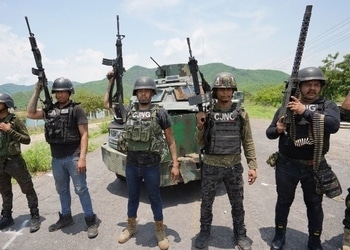Drone attacks in Michoacán, bodies hanging from bridges in Zacatecas, attacks with remotely detonated explosives in Guanajuato, massacres in Jalisco and Tamaulipas, remains scattered across streets in Baja California. These are some of the scenes seen in the last year blamed on the CJNG.
The Jalisco Cartel New Generation (Cártel Jalisco Nueva Generación – CJNG), led by Nemesio Oseguera Cervantes, alias “El Mencho,” has remained at the forefront of news media as well as national and international security policies due to the extreme violence which has accompanied its expansion.
Zacatecas, Michoacán, Guanajuato, Baja California, Sonora, Chihuahua and Morelos are the country’s most violent states, both in terms of homicide rates and total numbers of murders.
*This article first appeared in Sin Embargo and was translated, edited and published with permission. See the original here. It does not necessarily represent the views of InSight Crime.
In five of these seven states – with the exception of Sonora and Morelos – violence has been intricately linked to the CJNG’s rapid territorial spread, carried out with fire and blood, as it seeks to establish a criminal hegemony over all of Mexico, security experts explained.
SEE ALSO: Why the Jalisco Cartel Does Not Dominate Mexico’s Criminal Landscape
“These clashes are specifically due to the fact that it wants to consolidate itself as the dominant criminal group,” explained Amalia Pulido Gómez, a researcher at Mexico’s Center for Economic Research and Studies (Centro de Investigación y Docencia Económicas – CIDE).
According to Víctor Sánchez Valdez, a professor at the Autonomous University of Coahuila, homicides soar when two cartels fight for control of a specific area.
“And the CJNG is the criminal group that has expanded most notably in recent years across the country from its traditional heartlands in western and central Mexico,” he said.
“Through violence, death and fear, its instruments of war, el Mencho’s cartel controls territory nationwide, from Quintana Roo to Baja California,” added Ricardo Ravelo, a journalist specialized in security and organized crime.
“In Baja California, it sealed an alliance with the Tijuana Cartel, which has renamed itself the Tijuana Cartel New Generation, and is led by Enedina Arellano Felix, a member of the old guard. But the rest of its members are young, with few years of experience in organized crime,” he said.
In September 2021, Mexico’s Financial Intelligence Unit (Unidad de Inteligencia Financiera – UIF) identified the CJNG as having operations in 27 Mexican states out of 32.
For its part, the US Justice Department has called the CJNG the “most well-armed cartel in Mexico” while a report from the Drug Enforcement Administration (DEA) stated it had a presence in 26 American cities, including Orlando, Florida; Honolulu in Hawaii; and San Juan in Puerto Rico.
While the Sinaloa Cartel has been the major obstacle blocking the CJNG, they are far from the only rivals the CJNG is facing off against.

Jalisco Cartel Picks a Lot of Fights
One recurring aspect of the CJNG’s battle tactics has been their propensity for using technology for violent purposes. The most famous examples of this have taken place in Michoacán, Guanajuato and Jalisco, where the group has used drones carrying explosives.
Several of these drone attacks have happened in Aguililla, a town that has become the epicenter of the CJNG’s attempts to control the criminal miasma of Michoacán. Beyond being a key area for control of drug trafficking routes through the state, Aguililla is the birthplace of CJNG leader, El Mencho.
SEE ALSO: Jalisco Cartel News and Profile
There, it faces off against Cárteles Unidos, an alliance between a number of local groups, including the Viagras, the Cartel de Tepalcatepec and others. This town has become infamous for demonstrating the levels of criminal governance the CJNG is able to display, including installing barricades, displacing entire neighborhoods, controlling the police force, forcing the military to simply set up buffer zones and even requiring the participation of the Catholic Church as envoys.
In the rest of the state, the CJNG has run up against La Nueva Familia Michoacana, a revival of La Familia Michoacana which had its heyday between 2006 and 2010.
In Zacatecas, violence exploded in 2021 to make it the most murderous state in the country. This violence has been driven by the CJNG’s fights against its main rival, the Sinaloa Cartel, as well as their allies, the Taliban (Los Talibanes), a group with ties to the now-defunct Zetas.

In Guanajuato, remnants of the Santa Rosa de Lima Cartel continue to fight the CJNG, while in Morelos, the CJNG’s limited presence has seen them run up against the Rojos, a well-entrenched fragment of the Beltrán Leyva Organization (BLO).
And in Veracruz, the CJNG has clashed with Grupo Sombra, a splinter group of the Gulf Cartel (Cartel del Golfo – CDG), as well as the Old School Zetas (Zetas Vieja Escuela).
Experts agree that the CJNG’s rapid rise shows that Mexico’s capacity to respond has long been outpaced by its criminal groups.
For Ricardo Ravelo, the fragmentation of criminal structures and their dissemination across Mexico is not the only factor behind the persistent violence, with police and political corruption having long gone unaddressed.
“Criminal groups today have political control of municipalities and of the police. Eighty-five percent of municipalities in the country are governed by mayors financed by organized crime. The problem of narco-politics is not being dealt with with and President López Obrador doesn’t want to deal with this scourge, he doesn’t want to face up to powerful groups,” he stated.
Edgar Guerra Blanco, an investigative professor at CIDE’s drug policy program, adds that “the problem of criminal organizations…is so out of control that a single group, the CJNG, has managed in so little time to build up this immense firepower, economic power and political power in the regions. And we must remember that while the CJNG is a single organization, organized crime as a whole has overtaken the State ever since the war against drug trafficking was declared.”

